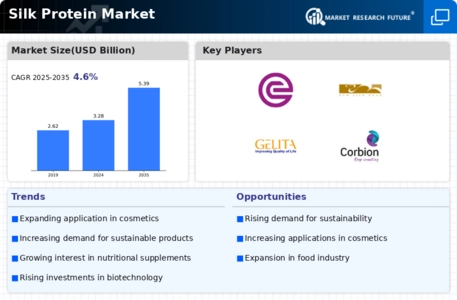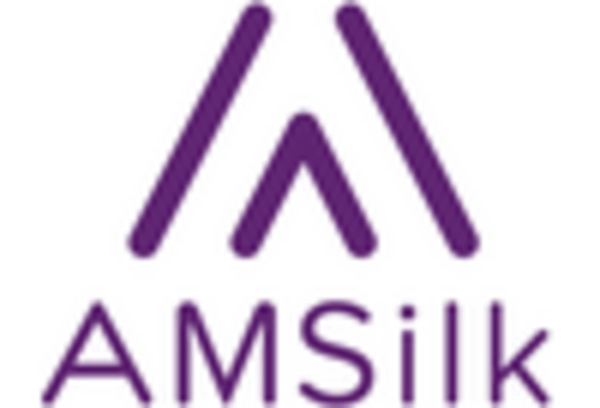Rising Consumer Awareness of Health Benefits
The Silk Protein Market is experiencing a notable increase in consumer awareness regarding the health benefits associated with silk proteins. These proteins are recognized for their high amino acid content, which is essential for muscle repair and growth. As consumers become more health-conscious, they are actively seeking products that incorporate natural and beneficial ingredients. This trend is reflected in the growing demand for silk protein supplements and functional foods, which are perceived as healthier alternatives to synthetic options. Market data indicates that the silk protein segment is projected to grow at a compound annual growth rate of approximately 8% over the next five years, driven by this heightened awareness. Consequently, manufacturers are increasingly focusing on incorporating silk proteins into their product lines to cater to this evolving consumer preference.
Diverse Applications Across Multiple Industries
The Silk Protein Market is characterized by its diverse applications across multiple industries, including food, cosmetics, and textiles. Silk proteins are increasingly being utilized in food products as natural additives that enhance texture and nutritional value. In the cosmetics sector, their unique properties contribute to formulations aimed at skin hydration and repair. Furthermore, the textile industry is exploring the use of silk proteins in creating innovative fabrics that offer enhanced durability and comfort. Market data indicates that the demand for silk proteins in these varied applications is expected to grow at a rate of 9% per year. This versatility not only broadens the market potential for silk proteins but also encourages cross-industry collaborations, further driving innovation and growth within the silk protein market.
Expansion of the Cosmetic and Personal Care Sector
The Silk Protein Market is significantly influenced by the expansion of the cosmetic and personal care sector. Silk proteins are valued for their moisturizing and skin-repairing properties, making them a sought-after ingredient in various beauty products. The increasing demand for anti-aging and skin-nourishing formulations has led to a surge in the incorporation of silk proteins in creams, serums, and hair care products. Market analysis suggests that the beauty and personal care segment utilizing silk proteins is expected to witness a growth rate of around 10% annually. This trend is further fueled by the rising preference for natural and organic ingredients among consumers, prompting brands to innovate and develop products that highlight the benefits of silk proteins. As a result, the silk protein market is poised for substantial growth within this sector.
Growing Demand for Sustainable and Ethical Sourcing
The Silk Protein Market is increasingly shaped by the growing demand for sustainable and ethically sourced ingredients. Consumers are becoming more discerning about the origins of the products they purchase, leading to a preference for silk proteins that are produced through humane and environmentally friendly practices. This shift is prompting manufacturers to adopt sustainable sourcing methods, such as using silk from farms that prioritize animal welfare and eco-friendly practices. Market trends suggest that products marketed as sustainably sourced are likely to command a premium price, thereby enhancing profitability for companies in the silk protein sector. As sustainability becomes a key purchasing criterion, the silk protein market is expected to expand, with a projected growth rate of 7% annually as brands align with consumer values.
Technological Advancements in Silk Protein Extraction
Technological advancements in silk protein extraction methods are playing a pivotal role in the Silk Protein Market. Innovations such as enzymatic extraction and biotechnological processes have enhanced the efficiency and yield of silk protein production. These advancements not only improve the quality of silk proteins but also reduce production costs, making them more accessible to manufacturers. As a result, the market is witnessing an influx of high-quality silk protein products that cater to various applications, including food, cosmetics, and pharmaceuticals. Data indicates that the adoption of these advanced extraction techniques could potentially increase the market share of silk proteins by 15% over the next few years. This trend underscores the importance of continuous research and development in driving the growth of the silk protein market.


















Leave a Comment